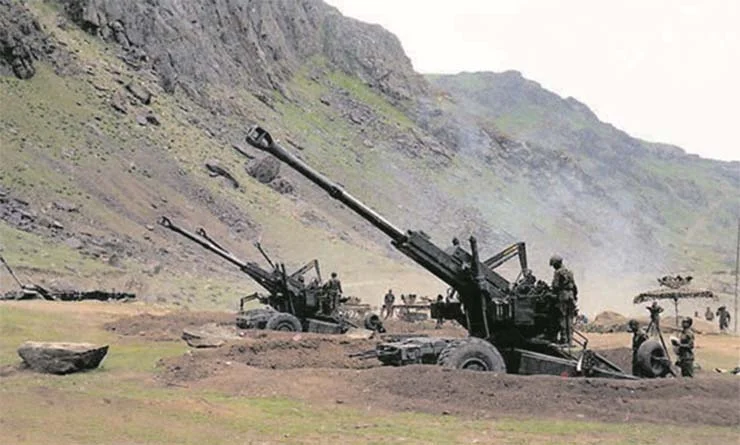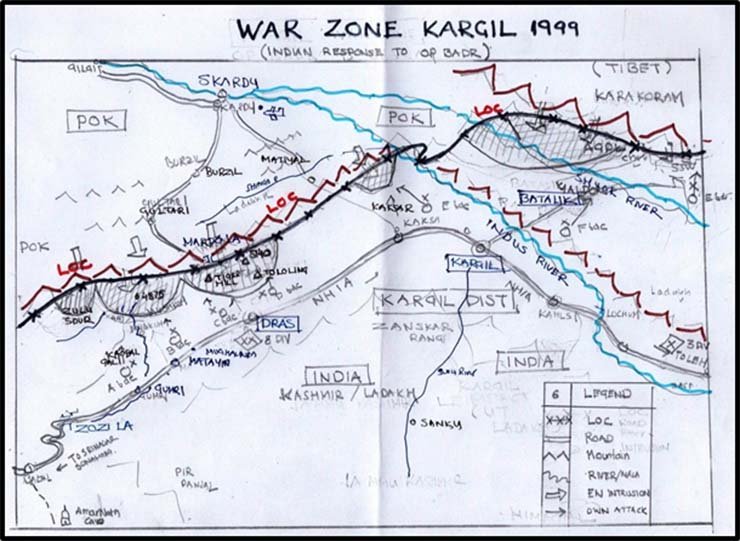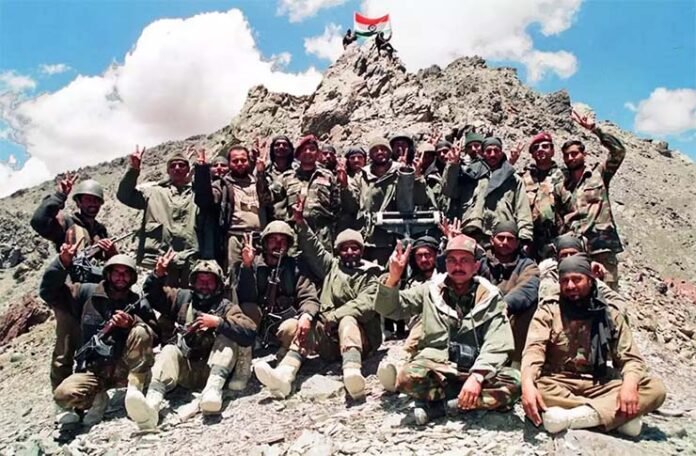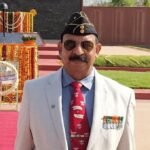The fifth round of War between India and Pakistan, which was fought in high altitude area of western Ladakh Ranges, came to an end as the then Indian Prime Minister Atal Bihari Vajpayee declared a unilateral ceasefire on July 26, 1999 after 83 days of intense fighting in the Himalayas, 26 years ago.
Admiring the valour, restraint and determination of the Indian Armed forces, he declared Operation Vijay a glorious Victory, as Line of Control (LOC) had been restored in Kargil heights. Operation ‘Al Badr’ launched by Pakistan in alliance with terror groups, was a naked betrayal as the two PMs were involved in Peace Talks at Lahore, while the Pak Army’s Northern Light Infantry units and Special Service Group troops were making deep intrusions across the Line of Control inside the Indian territory unnoticed by Indian Intelligence agencies.
Historically, the British had acted in vengeance, by drawing Radcliffe Line in western/eastern India, while departing, created Pakistan as separate nation out of India in 1947, ensuring that the Indian subcontinent remains a conflict zone for ever.
The first round of hostilities between the two nations started in September 1947, when Razakars in massive strength, supported and headed by Pak military officers, in rogue convoys advanced on Muzaffarabad- Baramulla-Srinagar axis.
The second round was initiated by Pakistan in September 1965 when Lal Bahadur Shastri was the PM. India was in a winning position as Indian troops had almost reached Lahore. India accepted the USSR mediated ceasefire and had to return almost 1920 sq km including strategic Haji Pir Pass at Tashkent summit.
Kargil War, the fifth round, was conceived by the Pak Army Chief General Parvez Musharraf to take revenge of the Siachen debacle during which his SSG troops were massacred. Operation ‘Al Badr’ also, the brain child of General Parvez Musharraf, was already underway when Lahore declaration was being signed between the two Prime ministers on February 21, 1999
The third round was a knockout blow to Pakistan in the 1971 war. A new nation Bangladesh was born and East Pakistan ceased to exist and 93,000 Pak troops surrendered.
The fourth round was fought in the highest battlefield of the world in 1984 called Operation Meghdoot, when Indian troops pre-empted Pak intentions and occupied 5,000 sq. kms of entire Siachen Glacier and Soltoro ridge. Pak troops suffered heavy casualties.
Kargil War, the fifth round, was conceived by the Pak Army Chief General Parvez Musharraf to take revenge of the Siachen debacle during which his SSG troops were massacred. Operation ‘Al Badr’ also, the brain child of General Parvez Musharraf, was already underway when Lahore declaration was being signed between the two Prime ministers on February 21, 1999.
It was based on “Koh Paima” a warfare strategy of Napolean Bonaparte, who adopted it in many wars meaning infiltrate fast from narrow points and spread fast in the rear of frontline enemy troops. Surprisingly, these Pak troops remained in inclement weather, dizzy heights, deadly blizzards, deep inside LOC for three months undetected until few Bakarwal goatherds informed the commanders in end-April, the presence of unknown troops above Kargil and Drass towns.

It was an intelligence blunder as everyone was celebrating the Lahore Peace process, while the Pak intrusion was on. But, once confirmed, Indian Army carried out the fastest mobilisation to counter the threat. Two divisions were inducted in the War Zone. As the red pins were marked in the Northern Army’s Operation Room, the situation was now clear
Detection Phase
The information was passed on to 121 Brigade. Ground patrols and aerial reconnaissance could not confirm the intrusions. Zojila pass was opened on April 28, 1999. Brig Commander ordered units to confirm any intrusion. The initial response at all levels was that it was a minor intrusion by small groups of militants to be cleared at Company level. The Defence Minister visited Kargil on June 8 . The fog of uncertainty and confusion was cleared as the badly mutilated bodies of Capt Saurabh Kalia and his soldiers were handed over by Pakistan on June 9.
The same day Kargil Ammunition Dump was bombarded by Pak Artillery Guns, Lt Gen Krishan Pal, GOC Chinar Corps had already assessed the critical situation and gave his plan to the Northern Army Commander Lt Gen H S Khanna confirming that it was not a militant intrusion but regular Pak troops consisting of Division Minus with Artillery support had intruded in Ladakh Ranges from Mashkoh, Drass to Yaldor in number of pockets.
It was an intelligence blunder as everyone was celebrating the Lahore Peace process, while the Pak intrusion was on. But, once confirmed, Indian Army carried out the fastest mobilisation to counter the threat. Two divisions were inducted in the War Zone. As the red pins were marked in the Northern Army’s Operation Room, the situation was now clear.
The Indian Army Chief Gen V P Malik who had gone to Poland on an official visit on May 9, returned home on May 19. Defence Minister George Fernandes was also abroad. Meanwhile, Six regiments of BOFORS/MBRLS were inducted. Operation Safed Sagar was launched by the Indian Air force on May 26, 1999 with 7 Combat Squadrons and One MI 17 Squadron. Indian Navy also initiated Op Talwar. Both Eastern and Western Naval Fleet moved to the high seas and blocked Karachi. Pakistan was shell shocked by the Indian Response.
Operation Tololing was the start point of Indian success story. Tololing top ( Pt 4590 ) standing tall on the ridge line is 5 Kms from Drass town and Pak troops had occupied it in strength, national highway was under observation of intruders. Pak Artillery Ops now could dominate the highway and were constant hazard to Indian troops and vehicular movement
Stabilisation and Restoration of the Situation
General Ved Prakash Malik was now crystal clear regarding the operational situation and also the extent of Intrusion. He had political clearance but with a rider that India will still respect the sanctity of the LOC and Indian Armed forces will not cross the LOC. However, the situation was not just confined to Kargil but was spread over several sub-sectors, as described in the following paragraphs.
Drass Sector
This sector was the initial responsibility of 121 Infantry brigade but as the situation deteriorated, 8 Mountain Division under Major General Mohinder Puri took over from June 8, 1999 the area between Zojila and Kargil, including Zulu, Muskoh, and Drass sub-sectors.
Operation Tololing was the start point of Indian success story. Tololing top ( Pt 4590 ) standing tall on the ridge line is 5 Kms from Drass town and Pak troops had occupied it in strength, national highway was under observation of intruders. Pak Artillery Ops now could dominate the highway and were constant hazard to Indian troops and vehicular movement.
On June 13, 1999, 2 Rajputana Rifles hoisted Tricolour once again on Tololing Top. 23 enemy soldiers were killed and 60 wounded. The entire Tololing complex was cleared on June 17, 1999. The victory march had begun.
Tiger Hill (Point 5062) is another majestic triangular snow covered peak which can be viewed on clear day from Drass War Memorial. It is about 10 Kms from Drass Town. It is much closer to LOC and has strategic importance. 18 Grenadier finally captured the Tiger Hill on July 4, 1999, a yet another landmark victory
Operation Point 5140 was another important action undertaken by 56 Mountain brigade. This feature is a dominating height 1500 metre North of Tololing. Point 5140 was fully cleared by 13 JAK Rifles. There was another feature on Tololing West Pt 4700, which was captured by 18 Garhwal on June 28, Point 5100 and three other pimples areas were cleared by 2 Raj Rifles by June 29 after fierce fighting suffering casualties. Major P Acharya, Capt Vijyant Thapar and Capt N Kungrese were fatally wounded during the difficult operation. The entire Ridge line in this sector was back in Indian hands.
Tiger Hill (Point 5062) is another majestic triangular snow covered peak which can be viewed on clear day from Drass War Memorial. It is about 10 Kms from Drass Town. It is much closer to LOC and has strategic importance. 18 Grenadier finally captured the Tiger Hill on July 4, 1999, a yet another landmark victory.
Mashkoh Sector
The Mashkoh Valley provided a direct route of infiltration to Doda-Bhadarwah areas of Jammu region bypassing the valley so the area need to be guarded by Indian forces but the region was unmanned before the Kargil War. Pak troops under Op Badr occupied few heights in this area and threatened the national highway near Mughalpura and Zojila pass. Pt 4875 was the most important feature in this area and strategic observation point.
13 JAK Rifles finally hoisted National Flag on Pt 4875 on the early morning of July 7, and brave Capt Vikram Batra succumbed to multiple gunshot wounds. He was awarded Paramveer Chakra posthumously. Pt 4875 was renamed as ‘Batra Top’ in his fond memory. Meanwhile,17 JAT and 2 Naga were dealing with other heights of Mashkoh. The areas Pimple and Whale back were cleared by 17 JAT on July 5, and 2 Naga captured Twin Bumps on July 6
13 JAK Rifles finally hoisted National Flag on Pt 4875 on the early morning of July 7, and brave Capt Vikram Batra succumbed to multiple gunshot wounds. He was awarded Paramveer Chakra posthumously. Pt 4875 was renamed as ‘Batra Top’ in his fond memory. Meanwhile,17 JAT and 2 Naga were dealing with other heights of Mashkoh. The areas Pimple and Whale back were cleared by 17 JAT on July 5, and 2 Naga captured Twin Bumps on July 6.
Kaksar Sector
Kaksar area lies between Drass and Batalik sector. It is almost north of Kargil town. The area remains glaciated and average height is about 15,000 feet. The main Ridge line comprised of Point 5608, Point 5605, and Point 5280. Operations were planned to clear the watershed on July 5, but as unofficial ceasefire had been announced, operations were stalled. Later, Kaksar sector was first to be vacated by the Pak troops by July 12 and the Indian troops occupied it by July 15, 1999.

Batalik Sector
Indus River flowing from Leh crosses the LOC between Batalik and Marol and goes towards Skardu. Batalik sector extends from Chorbat La in east to Shangurti in the west. The heights in this region vary from 15,000 to 18,000 feet with extreme cold conditions. 12 NLI Troops intruded 8-10 kms south of LOC in Jan/Feb 1999 and occupied summer mode defences, west of Chorbat La which were vacated during winter months. There were four ridge lines extending from north to south like Fingers from Knuckle. They are named Jubar, Kukarthang, Kalubhar and Churubar. Point 5190 and Point 5300 in Kalubhar–Jubhar were cleared on July 10, 1999, Later, Ladakh scouts and Paras cleared the Ring Contour and Pt 5289 by July 26. The enemy started withdrawing and sanctity of LOC was restored in Batalik-Yaldor sector. 70 Brigade had completed the task of clearing all four ridge lines. Lt Manoj Pandey 1/11 GR was awarded Paramveer Chakra posthumously. The cost of victory at Jubar-Kalubhar was very high.
The Fifth Round of War between two nations had ended with heavy cost to both sides. Himalayas once again witnessed the devotion and valour of Indian soldiers and shed tears for unsung heroes, who made supreme sacrifice for safeguarding the honour of the Motherland
Sub Sector West
This area was northern most area of Kargil War where LOC meets AGPL near Southern Glacier. The general are is known as Sub Sector West, and includes Turtuk and Chalunka hamlets. The entire sub sector was cleared of all intrusions by July 20, 1999.
All guns fell silent and all operations were ceased as India declared a Unilateral Ceasefire on July 26, 1999 as the Indian PM announced that our aim has been achieved and sanctity of LOC has been restored.
The Fifth Round of War between two nations had ended with heavy cost to both sides. Himalayas once again witnessed the devotion and valour of Indian soldiers and shed tears for unsung heroes, who made supreme sacrifice for safeguarding the honour of the Motherland.
A Kargil Review committee was appointed after the war to study the causes which resulted in this surprise War and the remedial actions. 14 Corps was raised to cover the Ladakh War zone. A new Chief of Defence staff was appointed. A new Defence (Integrated) Intelligence Agency, and Theatre Command concepts were initiated. The entire nation is indebted to 22 gallant officers, 21 JCOS and 452 brave soldiers of the Indian Army who made supreme sacrifices to protect and regain the Kargil heights and restore the sanctity of the Line of Control.
“IF DEATH STRIKES BEFORE, I PROVE MY BLOOD, I PROMISE I WILL KILL DEATH” – Lieutenant Manoj Pandey, 1/11 Gorkha Rifles, PVC (Posthumous)
-The writer is an Indian Army veteran and a defence analyst. He has keen interest in Geo-strategic affairs and writes regularly on internal and external affairs issues related to India and neighbours. The views expressed are personal and do not necessarily reflect the views of Raksha Anirveda






